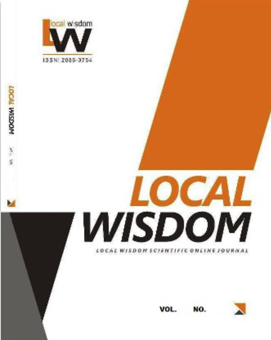Morphology of Settlement of the Dayak Kenyah Tribe, Budaya Pampang Village, Samarinda City in a Socio-Cultural Context
DOI:
https://doi.org/10.26905/lw.v15i1.7881Keywords:
Morphology, Budaya Pampang Village, Settlement, Socio-cultureAbstract
The Dayak Kenyah community is a dynamic tribe influenced by its socio-cultural context. Socio-cultural changes will affect the form of settlement. This journal focuses on the influence of the socio-cultural context on the settlement morphology of the Dayak Kenyah tribe in the Budaya Pampang Village to get meaning in forming their settlements. This study uses Levi-Strauss structuralism to see the meaning behind the relationship between the spatial morphology of settlements and socio-culture from data collection results such as physical evidence, interviews, and questionnaires. The results of this study found the meaning of defense, togetherness and kinship, spirituality, harmony with nature, and adaptation in the spatial formation of Dayak Kenyah settlements.
Downloads
References
AB, D. N. A., Dwisusanto, Y. B., & Pujianto, F. (2019). Concept of settlement in julah cultural village as a part of bali aga village reviewed on ritual, belief, and domestic routine aspects. Riset Arsitektur (RISA), 3(02), 170–187.
https://doi.org/10.26593/risa.v3i02.3278.170-187
Al-Mohannadi, A., Furlan, R., & Major, M. D. (2020). A Cultural Heritage Framework for Preserving Qatari Vernacular Domestic Architecture. Sustainability, 12(18), 7295. https://doi.org/10.3390/SU12187295
Billa, M. (2005). Alam lestari dan kearifan budaya Dayak Kenyah. Pustaka Sinar Harapan.
Brunskill, R. W. (1981). Traditional buildings of Britain: An introduction to vernacular architecture. London: Victor Gollancz.
Harsanto, F. H. (2018). Kenyah di Desa Budaya Pampang Studi Kasus Perubahan Sosial Buadaya Masyarakat Tahun 1972-2015. 88. http://repository.usd.ac.id/31939/2/144314008_full.pdf
Hofstede, G., Hofstede, G. J., & Minkov, M. (2005). Cultures and organizations: Software of the mind (Vol. 2). Mcgraw-hill New York.
Holton, R. J. (2011). Introduction to the Second Edition. In Globalization and the Nation State (pp. 1–30). Springer.
Kamalipour, H., & Zaroudi, M. (2014). Sociocultural context and vernacular housing morphology: A case study. Current Urban Studies, 2(03), 220. https://doi.org/10.4236/cus.2014.23022
Lawrence, R. J. (1987). Housing, dwellings and homes: Design theory, research and practice.
Mentayani, I., & Muthia, P. R. (2017). Menggali Makna Arsitektur Vernakular. Prosiding Temu Ilmiah IPLBI, 109–116.
Pergitawati, P., Ririn, A., & Ridjal, A. M. (2014). Perubahan Pola Ruang Dalam Rumah Lamin Adat Dayak Kenyah Akibat Pengaruh Modernisasi Di Desa Pampang, Samarinda. Arsitektur E-Journal, 7(2), 90–101. http://repository.ub.ac.id/id/eprint/143705
Putri, E. T., Ramadhan, T. A., Sandya, S. N., Fazriyah, D. M. N., & Maharani, P. S. (2019). Eksistensi Lamin Adat Pemung Tawai Sebagai Identitas Sosial Masyarakat Dayak Kenyah. Psikostudia: Jurnal Psikologi, 6(2), 58–69. https://doi.org/10.30872/psikostudia.v6i2.2377
Rapoport, A. (1969). House Form and Culture. New Jersey: Prenrice Hall. Inc. Englewood Cliffs.
Rapoport, A. (1990). The meaning of the built environment: A nonverbal communication approach. University of Arizona Press.
Rapoport, A. (1998). Using “culture†in housing design. Housing and Society, 25(1–2), 1–20.
Rapoport, A. (2005). Culture, architecture, and design. Locke science publishing Company.
Ratnasari, S. L., Susanti, E. N., Ismanto, W., Tanjung, R., Darma, D. C., & Sutjahjo, G. (2020). An experience of tourism development: how is the strategy? Journal of Environmental Management & Tourism, 11(7), 1877–1886.
https://doi.org/10.37631/pendapa.v3i1.102
Rengkung, J., Antariksa, S., & Murti Nugroho, A. Kindangen, J. J. (2018). Architectural Typology Dwelling House of Minahasan Ethnic in Talawaan Village, district of North Minahasa, Indonesia. International Journal of Applied Engineering Research, 13(2), 1007–1013. http://www.ripublication.com
Saleh, M. A. E. (2001). The evolution of planning & urban theory from the perspective of vernacular design: MOMRA initiatives in improving Saudi Arabian neighbourhoods. Land Use Policy, 18(2), 179–190.
Saleh, M. A. E. (2004). Learning from tradition: the planning of residential neighborhoods in a changing world. Habitat International, 28(4), 625–639.
Syahrozi, S. (2004). Bentuk Awal Komplek Huma Gantung Buntoi Kalimantan Tengah. Program Pasca Sarjana Universitas Diponegoro.
Widiastuti, T., Mihardja, E. J., & Agustini, P. M. (2020). Samarinda City Branding through Tourism Communication of Dayak Village in Pampang. Mediator: Jurnal Komunikasi, 13(1), 68–78. https://doi.org/https://doi.org/10.29313/mediator.v13i1.5654












